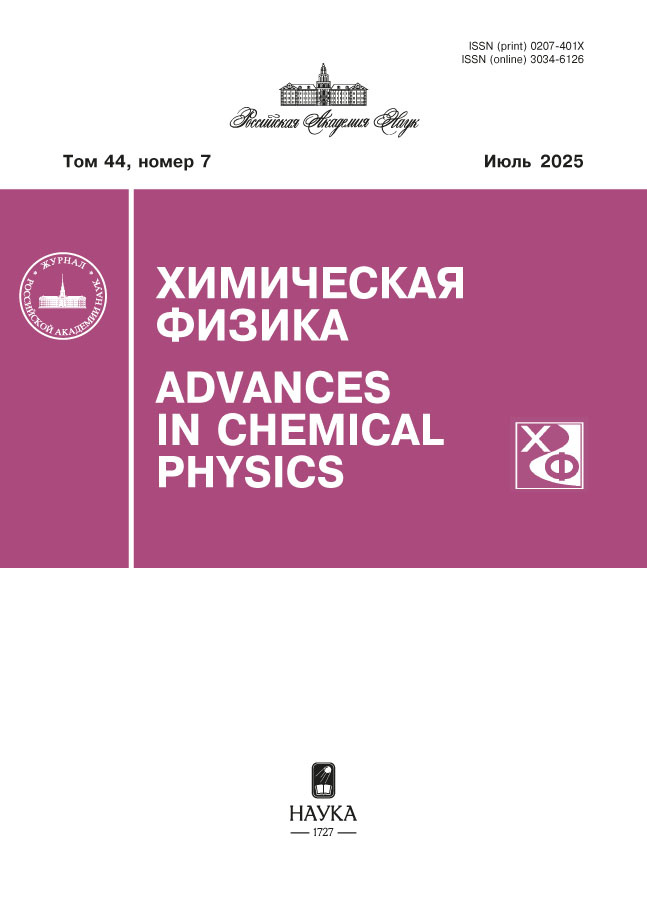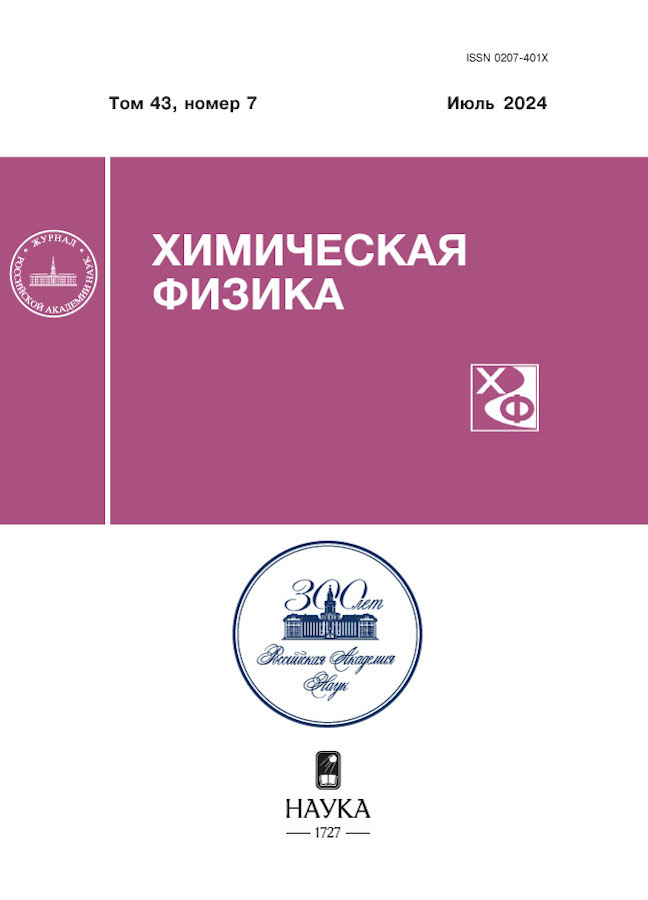Catalytic ignition of deuterium–air mixtures over a metallic rhodium surface at pressures of 1–2 atm
- Authors: Troshin K.Y.1, Rubtsov N.M.2, Chernysh V.I.2, Tsvetkov G.I.2, Shamshin I.O.1, Izmaylova Y.A.3, Kalinin A.P.4, Leont’ev A.A.3, Rodionov A.I.1,3
-
Affiliations:
- Semenov Federal Research Center for Chemical Physics, Russian Academy of Sciences
- Merzhanov Institute of Structural Macrokinetics and Materials Science, Russian Academy of Sciences
- Scientific and Technical Center “Reagent”
- Ishlinsky Institute for Problems of Mechanics, Russian Academy of Sciences
- Issue: Vol 43, No 7 (2024)
- Pages: 83-90
- Section: Combustion, explosion and shock waves
- URL: https://permmedjournal.ru/0207-401X/article/view/674927
- DOI: https://doi.org/10.31857/S0207401X24070086
- ID: 674927
Cite item
Abstract
The regularities of catalytic ignition of deuterium–air mixtures above the surface of metallic rhodium at pressures of 1–2 atm and temperatures of 20–250 °C using hyperspectrometers in the range of 400–1650 nm and high-speed filming have been established. It is established that the catalytic ignition of deuterium–air mixtures in the studied temperature range is observed at a deuterium content of more than 12%; and at a deuterium content of less than 12%, only intense heating of the catalytic wire is observed. It is shown that the initial ignition source occurs on the surface of the reactor. In subsequent experiments, under the same conditions, the location of the original center changes. It has been found that the upper limit of the catalytic ignition above the D2–air mixture is noticeably lower than the lower ignition limit of the H2–air mixture. Thus, D2 is more combustible than H2 over the surface of Rh at a pressure above 1 atm. The limits of catalytic ignition are even lower than 20 °C, although the flame velocity in hydrogen–air mixtures and the flame temperature in these mixtures of the same composition are much higher than those of deuterium–air mixtures. The nature of the detected kinetic inverse isotope effect is probably determined by the high level of activity of rhodium deuteride in relation to the deuterium oxidation reaction.
Full Text
About the authors
K. Ya. Troshin
Semenov Federal Research Center for Chemical Physics, Russian Academy of Sciences
Author for correspondence.
Email: troshin@center.chph.ras.ru
Russian Federation, Moscow
N. M. Rubtsov
Merzhanov Institute of Structural Macrokinetics and Materials Science, Russian Academy of Sciences
Email: troshin@center.chph.ras.ru
Russian Federation, Chernogolovka
V. I. Chernysh
Merzhanov Institute of Structural Macrokinetics and Materials Science, Russian Academy of Sciences
Email: troshin@center.chph.ras.ru
Russian Federation, Chernogolovka
G. I. Tsvetkov
Merzhanov Institute of Structural Macrokinetics and Materials Science, Russian Academy of Sciences
Email: troshin@center.chph.ras.ru
Russian Federation, Chernogolovka
I. O. Shamshin
Semenov Federal Research Center for Chemical Physics, Russian Academy of Sciences
Email: troshin@center.chph.ras.ru
Russian Federation, Moscow
Yu. A. Izmaylova
Scientific and Technical Center “Reagent”
Email: troshin@center.chph.ras.ru
Russian Federation, Moscow
A. P. Kalinin
Ishlinsky Institute for Problems of Mechanics, Russian Academy of Sciences
Email: troshin@center.chph.ras.ru
Russian Federation, Moscow
A. A. Leont’ev
Scientific and Technical Center “Reagent”
Email: troshin@center.chph.ras.ru
Russian Federation, Moscow
A. I. Rodionov
Semenov Federal Research Center for Chemical Physics, Russian Academy of Sciences; Scientific and Technical Center “Reagent”
Email: troshin@center.chph.ras.ru
Russian Federation, Moscow; Moscow
References
- L. Jewell, B. Davis, Applied Catalysis A: General 310, 1 (2006).
- J. E. Worsham, M. K. Wilkinson, C. G. Shull. Journal of Physics and Chemistry of Solids 3, 303 (1957).
- H. Chen, F.-S. Liu , Physics Letters A, 137, 485 (1989).
- N. M. Rubtsov, V. I. Chernysh, G. I. Tsvetkov, K. Ya. Troshin, Combust. Flame, 218, 179 (2020).
- F. Wesley, Table of recommended rate constants occurring in combustion. National bureau of standards, Washington DC, 1980.
- M. Fleischmann, and S. Pons, J. Electroanal. Chem. Interfacial Electrochem. 261, 301 (1989)
- C.P. Berlinguette, Y.M. Chiang, J.N.Munday et al., Nature 570, 45 (2019). https://doi.org/10.1038/s41586-019-1256-6
- A.E. Shilov, G.B. Shul’pin, Activation and catalytic reactions of saturated hydrocarbons in the presence of metal complexes, Springer Science & Business Media, 2001.
- K. Ya. Troshin, N. M. Rubtsov, G. I. Tsvetkov et al., Russian Journal of Physical Chemistry B 16, 693. (2022). https://doi.org/10.1134/S1990793122040303
- K. Ya. Troshin, N. M. Rubtsov, G. I. Tsvetkov, V. I. et al., Russian Journal of Physical Chemistry B 17. 979. (2023). https://doi.org/10.1134/S1990793123040310
- I. D. Rodionov, A. I. Rodionov, L. A. Vedeshin et al., Izvestiya Atmospheric and Oceanic Physics, 50, 989 (2014). https://doi.org/10.1134/S0001433814090175
- A.P. Kalinin, A.G. Orlov, A.I. Rodionov, K.Ya Tro shin // Physical-Chemical Kinetics in Gas Dynamics. 2009. V. 8. http://chemphys.edu.ru/issues/2009-8/articles/202/
- A.P. Kalinin, K.Ya. Troshin, A.G. Orlov, A.I. Rodio nov // Sensors and systems, 12, 19 (2008).
- N.M. Rubtsov, K.Ya. Troshin, M.I. Alymov, Catalytic ignition of hydrogen and hydrogen-hydrocarbon blends over noble metals, Springer International Publishing, 2023.
- D. Chalet, A. Mahe, J. Migaud and J.-F. Hetet, Applied Energy 88, 2988 (2011).
- K. Ya. Troshin, N. M. Rubtsov, G. I. Tsvetkov et al., Russian Journal of Physical Chemistry B 16, 39, (2022). https://doi.org/10.1134/S199079312201016X
- K. Ya. Troshin, N. M. Rubtsov, G. I. Tsvetkov et al., Russian Journal of Physical Chemistry. B 17, 979, (2023). https://doi.org/10.1134/S1990793123040310
- B. Lewis, and G. von Elbe, Combustion, Explosions and Flame in Gases, Academic, New York, London, 1987.
- A.P. Kreshkov, The grounds of analytical chemistry. V. 1. Theoretical grounds. Qualitative analysis, Moscow, Chemistry, 1970 (in Russian). High-resolution spectral modeling. https://www.spectralcalc.com/blackbody_calculator/blackbody.php
- M. Wang, H. An, W. Cai, X. Shao, Chemosensors, 11, 37 (2023). https://doi.org/10.3390/chemosensors11010037
Supplementary files














